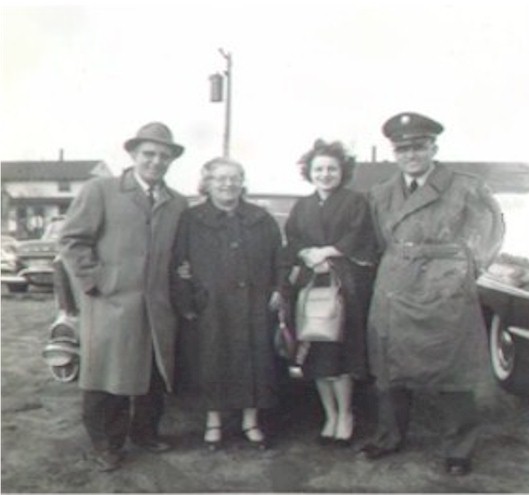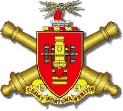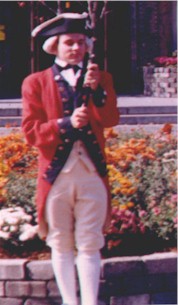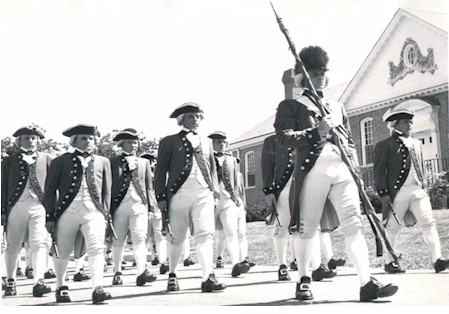Robert J. Arruda

Virginia

Robert John Arruda Or "Bob" as everyone calls him was the second child and oldest son of Anibel and Mary Santos Arruda. He originally joined the reserves in 1961 and was assigned to a reserve center in Danbury, Connecticut. He was attached to "C" Battery, 4th Howitzer Battalion, 40th Artillery. He went to Basic Training at Fort Dix, New Jersey then to Artillery School at Fort Sill, Oklahoma. After completion of training at Fort Sill he returned to his reserve unit in Connecticut, but not for long. Due to escalation of the Berlin Wall Crisis, President Kennedy ordered the army to call up its reserves. Bob was recalled to active duty. He served on Active duty for three years, first serving at Fort Bragg, North Carolina then at Fort Meyer, Virginia. At Fort Myer he would serve in the prestigious 3rd Infantry regiment "The Old Guard". While stationed at the "Old Guard" he would play in the recently established Fife and Drum Corps or FDC. He loved the FDC it but it wouldn't last forever. Soon the Army's needs would bring an end to this duty and he would report to Davison Army Airfield or DUSSA at Fort Belvior, Virginia. At DUSSA Bob would tire of the military regimen and separate when the opportunity arose.

click on photos to enlargeBob with his Company at Basic
BASIC TRAINING FORT DIX, NJUncle Bob arrived at Fort Dix from Bethel, Connecticut on February 19, 1961 and reported to the 3rd Training Regiment, receiving station 1264. He remained at Fort Dix for two months learning how to be a soldier. During that time Uncle Bob told me a story of how he started his music career in the military. A week after reporting to basic, the platoon was not doing so well, it seems they couldn’t march at all. The Drill Instructor was so frustrated he was willing to try anything, because screaming was not working. The D.I. asked if anyone in the platoon could play a musical instrument. Bob immediately shot up his hand. The Sergeant asked, "what instrument do you play?"Bob replied,"The Fife". "The Fife?" the sergeant asked inquisitively. "Where is your Fife?" Bob, a little unsure of what to expect replied "Back at home in Connecticut"The sergeant looked him over and yelled loud enough for the entire platoon to hear" Give that man a three day pass so he can go home and get his fife!" Bob was stunned as well as the rest of the platoon because no one got a three day pass in basic training. However, Bob went home and got his fife. The reason behind the fife as Bob would later learn was to help the troops learn to march. The sound of the music from Bob's fife allowed the troops to concentrate on their marching and improve. Uncle Bob continued to play his fife and he also continued his training. He graduated in April, 1961.

click on photos to enlargeBob with his Parents Anibel and Mary Arruda and his sister Patricia at Fort Dix
FORT DIX HISTORYFort Dix was named after Maj. Gen. John Adams Dix. Who, at age 14, served in the War of 1812, and later in the Civil War. He was a U.S. Senator, Treasury secretary, Ambassador to France, and The Governor of New York. The base was designated a permanent Army installation just prior to World War II, when it became the Fort Dix infantry basic training center. An estimated 9 million recruits have undergone training at Fort Dix. During the Second World War alone, there were approximately 3 to 5 million personnel trained there. Uncle bob completed training at Fort Dix and then reported to Fort Sill, Oklahoma.

ARTILLERY SCHOOL-FORT SILL, OKLAHOMA Uncle Bob transferred to Fort Sill to learn how to be an Artillery man or "Cannon Cocker" as he calls it. he would train on all kinds of artillery weapons, but one in particular he would learn was the 105MM howitzer that was used by his reserve unit.
Fort Sill Oklahoma The origin of the United States Army Field Artillery School (USAFAS) can be traced back to the 1907 reorganization of the Artillery Corps and to the character of Fort Sill at that time. The 1907 reorganization created two artillery branches: The Coastal and the Field. In the process of this reorganization, the Field Artillery was deprived of its former home at Fort Monroe, Virginia.
Fort Sill was considered the best location for a field artillery school, since its 15,000-acre reservation allowed ample room for target practice and its great variety of terrain offered an excellent area for different types of tactical training. In addition, the Post had already assumed the character of the home of artillery with a large number of artillery units assigned.

click on photo to enlarge105MM HT Howitzer in action
The first artillery school, the US Army School of Fire, was organized in 1911 by Captain Dan T. Moore. With the exception of a brief period in 1916 when school troops were used as frontier security guards during the Mexican Revolution, the School has operated and expanded continuously. Literally hundreds of thousands of artillery men have been trained at Fort Sill since the inception of the School. After Bob completed his training at Fort Sill he returned to his reserve center in Bethel, Connecticut. This however would not last long.

BERLIN WALL CRISES 1961While Bob was home the Berlin Crises was developing in Germany. President Kennedy as a precautionary measure ordered the Army to call up some of its reserves. Bob was lucky enough to get called up. The Crises started early in the morning of Sunday, August 13, 1961, the German Democratik Republik (GDR) under the leadership of Erich Honecker began to block off East Berlin and the GDR from West Berlin by means of barbed wire and antitank obstacles. The streets were torn up, and barricades of paving stones were erected. Tanks gathered at crucial places while the subway, and local railway services between East and West Berlin were interrupted. Inhabitants of East Berlin and the GDR were no longer allowed to enter West Berlin, amongst them were 60,000 commuters who had worked in West Berlin. In the following days, construction brigades began replacing the provisional barriers by a solid wall.

click to enlargeEast German workers building the wall
The reaction of the western allies was of great concern even though the presence of allied troops were there. The free access to Berlin, and the right of self-determination was still available to West Berliners.
After August 1961, citizens of West Berlin were no longer allowed to enter East Berlin. In September the forced evacuation of houses situated immediately at the border to West Berlin began. Two months before the wall was built. Walter Ulbricht, then East German leader, declared at an international press conference on June 15, 1961:
"I understand your question rightly that there are people in West Germany who wish that we mobilize the building worker of the capital of the German Democratic Republic to build up a wall. Not that I am aware of a such intention exists. The building workers of our capital are mainly busy with house building and their manpower is fully used for that."
So the crises began and with it President Kennedy ordered Defense Secretary Robert McNamara to call up the reserves. This point in the Cold War is when many men were called to active duty including my father. Uncle Bob was in the reserves so they were called first. My father was lucky because my mom was pregnant with me and so he was not drafted, but Uncle Bob wasn’t so lucky.


click to enlargeleft-Check Point Charlie - The American Sector 1961
right-The Berlin Wall in front of the Brandenburg Gate
FORT BRAGG, NCOnce Uncle Bob was recalled to active duty, he had to report to Fort Bragg in North Carolina. He remained there from October until April 1962. The post came into existence in 1918, when 127,000 acres of desolate sand hills and pine trees were designated as a U.S. Army installation. Adequate water, rail facilities and the Carolina climate lent themselves to Army needs and Camp Bragg emerged as a field artillery site on August 21, 1918. It was named in honor of Confederate General Braxton Bragg, a former artillery officer and North Carolinian.
Congress decided in February 1922 that all artillery sites east of the Mississippi River would become permanent Army posts. The camp was redesignated as Fort Bragg, September 30, 1922.
The fort grew slowly, reaching a total of 5,400 soldiers by the summer of 1940. With the threat of World War II and passage of the Selective Service act, a reception station was built here and Fort Bragg exploded to a population of 67,000 soldiers within a year. In 1942, the first airborne units trained here in preparation for combat. All five World War II airborne divisions the 82nd, 101st, 11th, 13th and 17th, trained in the Fort Bragg-Camp Mackall area.
The 82d Airborne Division was assigned here in 1946, upon its return form Europe. In 1951, XVIII Airborne Corps was reactivated here and Fort Bragg became widely known as the "home of the airborne." In April of 1962 Bob would reenlist and transfer to Fort Meyer, VA.
 Military District Washington
Military District Washington
FORT MEYER, VA
Bob would transfer to Fort Meyer in the spring of 1962. Fort Meyer traces its origin as a military post back to the Civil War. Since then it has been an important Signal Corps post, a showcase for Army cavalry, and the site of the first flight of an aircraft at a military installation--as well as the first military air fatality. Fort Myer has been the home of Army chiefs of staff for a century, and today is home for service members working throughout the Military District of Washington and the National Capital Region. Bob reenlisted for a reason and Fort Meyer was that reason. Fort Meyer was the home of the 3rd Infantry regiment or the "Old Guard". It also was home to the newly established Fife and Drum Corps.

3rd INFANTRY REGIMENT ”THE OLD GUARD”The history of the Old Guard is unique. Since World War II, The Old Guard has served as the Army's Official Ceremonial Unit and Escort to the President of the United States. In that capacity, 3d Infantry soldiers conduct military ceremonies at the White House, the Pentagon, national memorials, and elsewhere in the National Capital Region. Old Guard soldiers also maintain a 24-hour vigil at The Tomb of the Unknown Soldier, provide military funeral escorts at Arlington National Cemetery, and participate in parades at Fort Myer and throughout the National Capital Region.
The dates of origin for 3d Infantry and some of its elements are below:
The Regiment, called the 1st American Regiment: 3 June 1784
Re-designation as the 3d US Infantry: May-October 1815
First use of historical uniforms for official purposes
(in a color guard): 1922
Inactivation: 20 November 1946
Reactivation: 6 April 1948
MDW Ceremonial Company becomes A Company: 1950
President Truman presents the Presidential Baton
to the Regiment, and names it
"Honor Guard to the President": 10 April 1952
Organization of the US Army Drill Team: 1957
Organization of the Fife and Drum Corps: 1960
Official "traditional designation" of 3d Infantry as
"The Old Guard" recognized: 1963

Bob in Traditional Period Uniform
THE FIFE AND DRUM CORPSUncle Bob was offered the opportunity from his Colonel to reenlist and go to the Old Guard Fife and Drum Corps(FDC). He jumped at the chance. The FDC is the only unit of its kind in the armed forces, and is part of the 3rd U.S. Infantry (The Old Guard).
The musicians of this unit recall the days of the American Revolution as they parade in uniforms patterned after those worn by the musicians of Gen. George Washington's Continental Army. Military musicians of the period wore the reverse colors of the regiments to which they were assigned. The uniforms worn by the members of the Corps are dated circa 1781, and consist of black tricorner hats, white wigs, waistcoats, colonial coveralls, and red regimental coats. The drum major of the unit is distinguished from the other musicians by his headgear, the light-infantry Cap. In contrast to modern Army bands, and as an indication of prominence, he carries an espontoon instead of the standard mace. The espontoon is an 18th century weapon carried by officers. However, it is used by the drum major to issue silent commands to the Corps.
The 69-member Corps uses 11-hole fifes, handmade rope-tensioned drums and single-valve bugles, which bring to life the exciting sounds of the continental army. While traveling, the marching strength of the unit is normally 22 musicians, and the drum major and support personnel.
In support of the president, the Corps performs at all armed-forces arrival ceremonies for visiting dignitaries and heads of state at the White House, and has participated in every Presidential Inaugural Parade since President John F. Kennedy's in 1961.

click to enlargeBob marching with the FDC

Recon Map of the Missile sites
CUBAN MISSILE CRISES- 1963While Bob was playing for President Kennedy at his receptions at the Whitehouse some interesting developments would soon over take the young presidents attention.
The closest the world has come to nuclear war was the Cuban Missile Crisis of October 1962. The Soviets had installed nuclear missiles in Cuba, just 90 miles off the coast of the United States. U.S. armed forces were at their highest state of readiness. Soviet field commanders in Cuba were authorized to use tactical nuclear weapons if invaded by the U.S. The fate of millions literally hinged upon the ability of two men, President John F. Kennedy and Premier Nikita Khrushchev, to reach a compromise.
Click here for more on the Cuban Missile Crises

JFK and Jackie arriving at the Love Field Airport in Dallas on November 22, 1963
Click on Photo for more on the JFK Assassination
ASSASSINATION OF PRESIDENT KENNEDYAlso while Bob was on active duty, the single most influential event of the latter half of the twentieth century would take place in Dallas Texas in the late autumn of 1963.
John F. Kennedy visited Dallas on November 22, 1963. On his arrival at 1140 hours, the people of Dallas warmly welcomed him. Kennedy, Governor John Connolly and their wives sat down in the limousine of the President, which led the motorcade through the town. When the motorcade arrived in Dealey Plaza at 1230 hours, it turned right from Main to Houston Street and just seconds later it took the 120-degree turn onto Elm Street passing the Schoolbook Depository Building. Just when the limousine passed the Stemmons Freeway sign, Mrs. Connolly heard a kind of gunshots. When she turned, looking at the President, she saw him taking his hand to his throat covering a shooting wound. The next second Governor Connolly felt an ache in his back, which he recognized as a shot. Just seconds later he heard the third shot. Mrs. Kennedy, who then believed she was hearing firecrackers from the motorcade, heard "terrible noises" and turned to Kennedy. She saw her husband being wounded by the infamous headshot. This was the final, fatal shot at Dealey Plaza.
Click here for more on the JFK Assassination

Click on Photo to read more on this presidential Aircraft.
DAVISON ARMY AIRFIELD, (DUSSA)Uncle Bob was transferred from Fort Meyer to Fort Belvior. By sheer fate he would take a typing test, and a superior officer would later see his score and have him reassigned from his beloved Old Guard. Bob transferred to Davison Army Airfield, in 1964 .Davison is 15 miles southwest of Washington at Fort Belvoir, VA. It was named in honor of Brig. Gen. Donald A. Davison, noted aviation engineer during World War II.
It became part of Fort Belvoir's Engineer School on Sept. 2, 1952. Less than two years later, Aug. 1, 1954, it was reassigned to the U.S. Army Military District of Washington. It has remained a subordinate installation of MDW ever since.
The airfield has a 4,030-foot runway, occupies more than 500 acres, has 36 buildings and employs almost 400 people. The airfield has housed several aviation commands through the years, but the most visible mission has been providing fixed- and rotary-wing priority air transport to the Army, Department of Defense, federal-government officials and foreign dignitaries.
MDW's aviation-support unit, the 12th Aviation Battalion is stationed at Davison Airfield. It is made up of three helicopter companies, a helicopter-maintenance company, base operations and Headquarters Company. The battalion operates helicopters in support of training and contingencies for the 3rd U.S. Infantry (The Old Guard) and other MDW units. It also provides airlift to the highest level of the Army and DoD.
From 1957 to 1976, Davison provided presidential helicopter support, with the command's Executive Flight Detachment flying missions supporting Presidents Eisenhower, Kennedy, Johnson, Nixon and Ford. This mission was transferred entirely to the Marine Corps in July 1976.
Uncle Bob elected to leave the service in April 1965. He went to work for the Western Electric Company and remained there through out all the Bell changes. he still works there 35 years later.
Sadly, on January 11, 2008 Uncle Bob passed away from Cancer. I will miss him dearly as he was one of my favorite Uncles. God bless him and keep him.

click to enlargeMore on the FDC
HOME


















